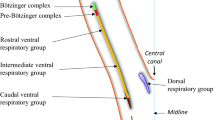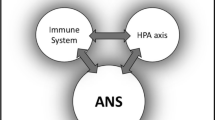Summary
The effects of an opioid receptor antagonist, naloxone (NAL), were studied on the changes in pituitary hormone secretion induced by emotional stress. Male Wistar rats were trained with tone stimuli paired with electric footshocks and tested with the tone and environmental cue signals for emotional stress of fear acquired by learning as described previously (Onaka et al. 1988). Rats received s.c. injected NAL 30 min before testing at doses of 0, 0.2, 1.0, 5.0 and 25.0 mg/kg b.w. Half the rats were injected with 0.5 M NaCl (20 ml/kg b.w.) together with NAL. In these hypertonic rats plasma vasopressin level was slightly increased after NAL. The increment was statistically significant in control groups but not in experimental groups. However the suppression of vasopressin secretion by emotional stimuli was not changed by NAL. Plasma oxytocin levels were extremely high and not significantly different among experimental, unshocked control and untested control groups. NAL further increased the oxytocin level dose-dependently. NAL did not significantly change plasma adrenocorticotrophic hormone (ACTH) levels and hence did not modify the augmentative response in ACTH secretion to emotional stimuli. Plasma prolactin level was significantly elevated after emotional stimuli and NAL depressed the prolactin level in each of experimental and control groups. After NAL, the magnitude of the facilitatory response in prolactin secretion to emotional stimuli was decreased. Motor activity and its suppressive response to emotional stimuli were not influenced by NAL. In another half of rats under a normal osmotic condition the vasopressin response to emotional stimuli was not affected by NAL. NAL further augmented potentiation of oxytocin secretion after emotional stimuli dose-dependently. Effects of NAL on ACTH level, prolactin level and motor activity were similar to those in rats under hypertonic conditions. These results demonstrate that endogenous opioids are selectively and differentially involved in hypothalamo-hypophysial responses to fear-related emotional stress.
Similar content being viewed by others
References
Buckingham JC, Cooper TA (1986) Effects of naloxone on hypothalamo-pituitary-adrenocortical activity in the rat. Neuroendocrinology 42:421–426
Bunnell BN, Meyerhoff JL, Kant GJ (1988) Psychological stress increases pituitary cyclic AMP. Pharmacol Biochem Behav 29:151–155
Carter DA, Williams TDM, Lightman SL (1986) A sex difference in endogenous opioid regulation of the posterior pituitary response to stress in the rat. J Endocrinol 111:239–244
Chance WT, White AC, Krynock GM, Rose-crans JA (1978) Conditional fear-induced antinociception and decreased binding of [3H]N-Leu-enkephalin to rat brain. Brain Res 141:371–374
Cover PO, Buckingham JC (1989) Effects of selective opioid-receptor blockade on the hypothalamo-pituitary-adrenocortical responses to surgical trauma in the rat. J Endocrinol 121:213–220
Fanselow MS, Bolles RC (1979) Naloxone and shock-elicited freezing in the rat. J Comp Physiol Psychol 93:736–744
Ferland L, Kledzik GS, Cusan L, Labrie F (1978) Evidence for a role of endorphins in stressand suckling-induced prolactin release in the rat. Mol Cell Endocrinol 12:267–272
Forsling ML, Matziari C, Aziz L (1988) A comparison of the vasopressin response of rats to intraperitoneal and intravenous administration of hypertonic saline, and the effect of opioid and aminergic antagonists. J Endocrinol 116:217–224
Gibbs DM (1986) Vasopressin and oxytocin: hypothalamic modulators of the stress response: a review. Psychoneuroendocrinology 11:131–140
Gibson A, Ginsburg M, Hall M, Hart SL (1979) The effects of opiate receptor agonists and antagonists on the stress-induced secretion of corticosterone in mice. Br J Pharmacol 65:139–146
Grandison L, Guidotti A (1977) Regulation of prolactin release by endogenous opiates. Nature 270:357–359
Hartman RD, Rosella-Dampman LM, Emmert SE, Summy-Long JY (1986) Otogeny of opioid inhibition of vasopressin and oxytocin release in response to osmotic stimulation. Endocrinology 119:1–11
Higuchi T, Honda K, Fukuoka T, Negoro H, Wakabayashi K (1985) Release of oxytocin during suckling and parturition in the rat. J Endocrinol 105:339–346
Knepel W, Nutto D, Hertting G (1982) Evidence for inhibition by ß-endorphin of vasopressin release during foot shock-induced stress in the rat. Neuroendocrinology 34:353–356
Lang RE, Heil JWE, Ganten D, Hermann K, Unger T, Rascher W (1983) Oxytocin unlike vasopressin is a stress hormone in the rat. Neuroendocrinology 37:314–316
Lightman SL, Young III WS (1987) Changes in hypothalamic preproenkephalin A mRNA following stress and opiate withdrawal. Nature 328:643–645
Madden J, Akil H, Patrick RL, Barchas JD (1977) Stress-induced parallel changes in central opioid levels and pain responsiveness in the rat. Nature 265:358–360
Onaka T, Hamamura M, Yagi K (1986a) Potentiation of vasopressin secretion by foot shocks in rats. Jpn J Physiol 36:1253–1260
Onaka T, Hamamura M, Yagi K (1986b) Suppression of vasopressin secretion by classically conditioned stimuli in rats. Jpn J Physiol 36:1261–1266
Onaka T, Yagi K, Hamamura M (1988) Vasopressin secretion: suppression after light and tone stimuli previously paired with foot shocks in rats. Exp Brain Res 71:291–297
Onaka T, Yagi K (1988) Bimodal effects of noxious stimuli on vasopressin secretion in rats. Neurosci Res 6:143–148
Paterson SJ, Robson LE, Kosterlitz HW (1983) Classification of opioid receptors. Br Med Bull 39:31–36
Rosella-Dampman LM, Keil LC, Chee O, Summy-Long JY (1983) Naltrexone effects on plasma vasopressin concentration elevated and lowered by various stimuli. J Pharmacol Exp Ther 226:373–381
Rosella-Dampman LM, Summy-Long JY (1985) Dexamethasone differentially alters naltrexone effects on vasopressin and oxytocin release during tail electroshock. Brain Res Bull 15:587–593
Rossier J, French ED, Rivier C, Ling N, Guillemin R, Bloom FE (1977) Foot-shock induced stress increases ß-endorphin levels in blood but not brain. Nature 270:618–620
Samson WK, McDonald JK, Lumpkin MD (1985) Naloxoneinduced dissociation of oxytocin and prolactin releases. Neuroendocrinology 40:68–71
Shin SH (1978) Blockage of the ether-induced surge of prolactin by naloxone in male rats. J Endocrinol 79:397–398
Siegel RA, Chowers I, Conforti N, Feldman S, Weidenfeld J (1982) Effects of naloxone on basal and stress-induced ACTH and corticosterone secretion in the male rat-site and mechanism of action. Brain Res 249:103–109
Summy-Long JY, Miller DS, Rosella-Dampman LM, Hartman RD, Emmert SE (1984) A functional role for opioid peptides in the differential secretion of vasopressin and oxytocin. Brain Res 309:362–366
Tapp WN, Mittler JC, Natelson BH (1981) Effects of naloxone on corticosterone response to stress. Pharmacol Biochem Behav 14:749–751
Van Vugt DA, Bruni JF, Meites J (1978) Naloxone inhibition of stress-induced increase in prolactin secretion. Life Sci 22:85–90
Author information
Authors and Affiliations
Rights and permissions
About this article
Cite this article
Onaka, T., Yagi, K. Differential effects of naloxone on neuroendocrine responses to fear-related emotional stress. Exp Brain Res 81, 53–58 (1990). https://doi.org/10.1007/BF00230100
Received:
Accepted:
Issue Date:
DOI: https://doi.org/10.1007/BF00230100




